|
In view of the ban on public meetings, the Coronavirus has put paid to the
normal range of Surrey Vintage Vehicle Society outside and inside gatherings. We
have therefore encouraged all our members to take photographs instead of any of
their allowable distancing machinery and share them on our website. Many of our
Members are of the 'elderly variety' so were hankered deep down thinking of
survival rather than escape, but some have been exercising their cars in very
small select covid-secure ways and some have even been 'socially cycling' and
have sent reports and photos to us. ALL WRITE-UPS
and PHOTOS WELCOME !!
 Reigate Hill Climb,
1880 - Part 2. Reigate Hill Climb,
1880 - Part 2.
 by
Chas Moody by
Chas Moody


The 140th Anniversary of the "Reigate Hill Climb" was on 4th
September this year, 2020. As this was many years before motor vehicles were
invented, the race was for Penny
Farthings. In
Part One last month we described the
event which started at The Grapes Hotel in Bell Street, Reigate, going north
towards the Tunnel, then through Reigate Tunnel, over the railway line and up
the hill, a narrow road constructed of graded stones, finishing at the 'suspension
bridge' at the top of Reigate Hill. Part
One also describes the history of the
hotel, Reigate Tunnel, and the suspension bridge.
|
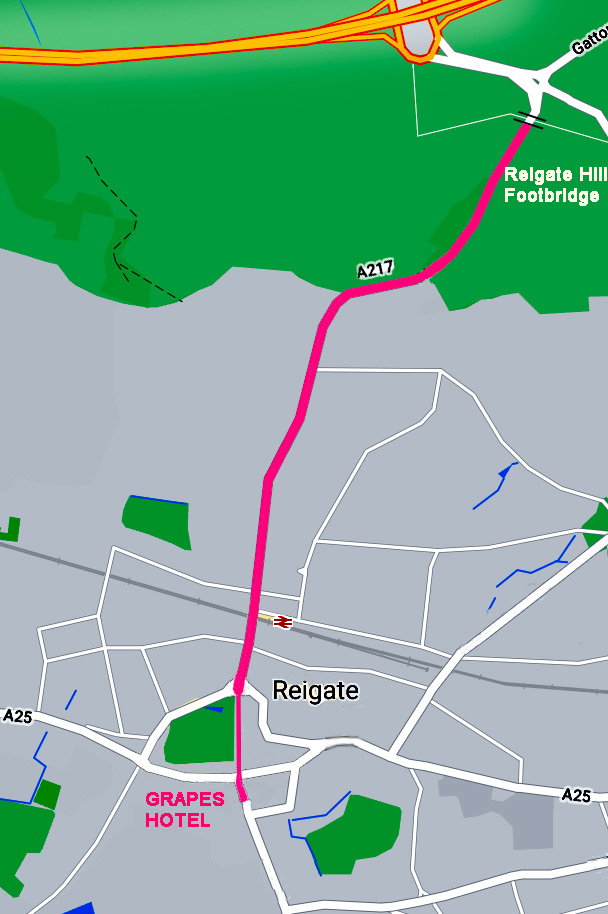
Current map showing same route, when the Tunnel was main A217
London road and before motorways had been thought of.
|
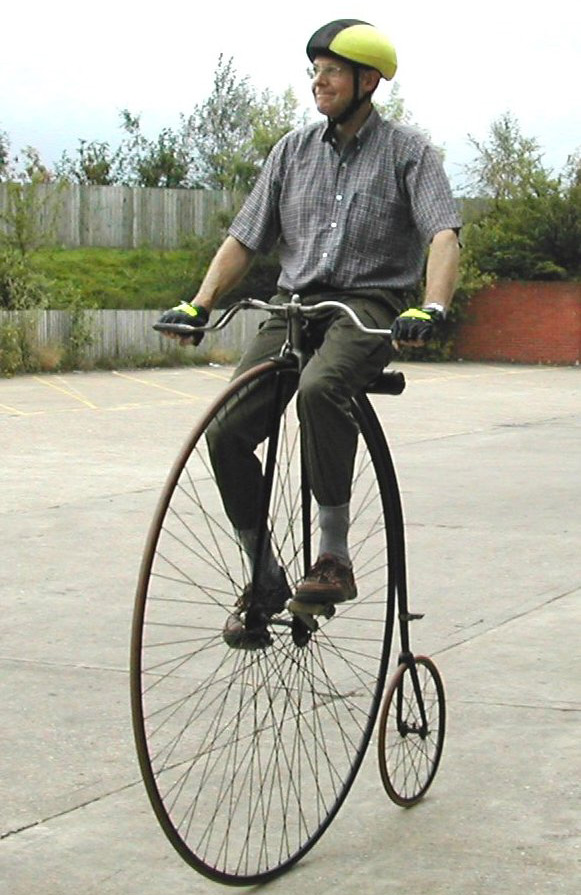
Chas Moody has a Penny Farthing, a 1885 Victor Ordinary, but
but due modern traffic had to use his 1909 New Hudson Safety
|
It's 8.45am on August Bank Holiday Monday. I'm in
Bell Street, Reigate, about to cycle up Reigate Hill, as mentioned in part one
of this article, in order to mark the 140th Anniversary of the hill climb which
took place in 1880. Opposite, is the site of what was once The Grapes Hotel, the
starting point for the hill climb contest. The only evidence of the Hotel's
location is the lantern fixed to the front of the present building, in recent
years occupied by Knight's the Drapers and now Oliver Bonas, a ladies dress
shop. The front glass pane of the lantern bears the legend "The Old Grapes
Inn c.1768 - 1911". Most of the buildings in sight existed in 1880,
although are now substantially altered with different uses.
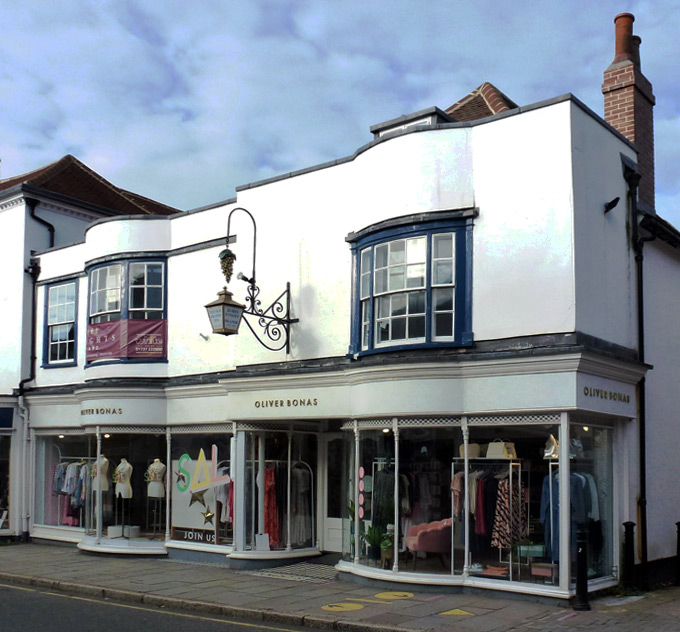

The riders of 1880 would be surprised to see the asphalted roads of today and
the electric traffic lights, which I await to signal my start. The 'Wheelmen'
might also be amazed to see my chosen mount as, much as I would have liked to
attempt the ride on my 1885 54" wheel Victor 'Ordinary', good sense has
prevailed regarding safety, etc. and I am using the 1909 New Hudson 'Safety
Bicycle' which had yet to be invented in 1880 (see photo at top of the page).
The bike has an Armstrong 3-speed gear, the lowest ratio of which is expressed
as 54 inches, which means that for one rotation of the pedals it would travel
the same distance as a penny farthing with a 54 inch front wheel, which could
well have been the driving wheel size of many of the high-wheelers taking part
in 1880. The New Hudson weighs 37 lbs which is not far from the 40 to 45 lbs for
an Ordinary Bicycle recommended by the eventual winner, Charles Crute in his
treatise on Hill Climbing in 'The Wheel World' Christmas Annual 1880, shown
below.
 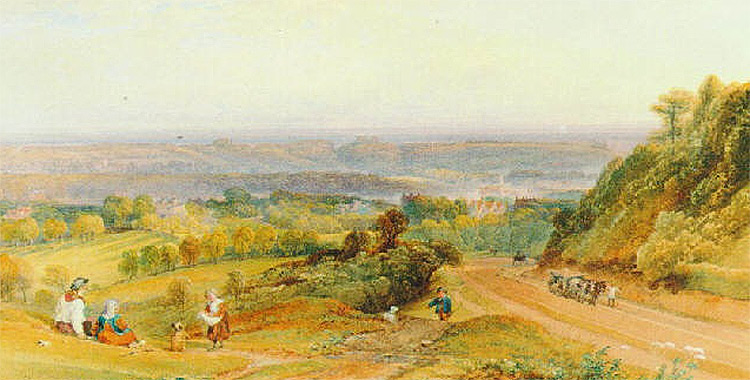
My early start time is to avoid the traffic, which of course was of a totally
different nature in 1880, when the start time of the first rider was 4.28 pm,
presumably arranged not to interfere with the business of the day, Saturday
market shopping, etc. A list of the 74 riders, which had been reduced from an
initial entry of 155 by ballot, was published in the Mid Surrey Mirror on 4th
September 1880, the day of the hill climb. The following week the same newspaper
printed a report which gives interesting details of the proceedings and begins:
"Under most inspiriting conditions, favoured with very fine weather, and
viewed by a large number of spectators, the event we announced in our last duly
took place on Saturday afternoon." The report appears in full at the bottom
of the page. It is interesting to note the following comments:- "The whole
line of route was thronged with spectators." "The level crossing at
the Railway Station was the centre of a crowd of people, who no doubt
anticipated accidents." "The starting point, in the Market Place, was
by no means an exciting situation, the middle of the tramway and the summit, the
most difficult points, being the most in favour by the public."

So, whilst Bell Street may well have been a hive of activity and splendour with
many of the competitors dressed in military style club uniforms preparing to
start with their 'high wheel' machines of various makes, their attendants,
officials and local dignitaries - the general public were legging it up the hill
to see some of the action! Many of the competitors would have journeyed with
their machines by train to Reigate and possible stayed at the 'Grapes'. The
eventual winner, Charles Crute, Captain of the Sutton Bicycle Club may well have
ridden from Sutton by way of a 'warming up' run. These were fit, athletic young
men - it is said that members of the Sutton Bicycle Club founded the Sutton and
Epsom Rugby Football Club the following year in order to keep fit in the winter
season, which explains the 'penny farthing' logo used by the rugby club to this
day.
Back to the matter in hand. The lights turn green, I start the watch and set
off. Yes, I'm timing the ride but should point out that I have never cycled
competitively, apart from my famous victory in 1999 at the Herne Hill Velodrome
in the slow bicycle race at the Veteran Cycle Club family fun day on this very
machine! Into Tunnel Road, up through the tunnel, then, preparing to dismount to
negotiate the pedestrian crossing onto the island which forms part of the
one-way system.
 
A car obligingly beckons me across -
thanks! Now crossing the island, no cars coming so I'm heading towards the
railway level crossing (the only part that is level!), hopefully having timed my
start correctly to miss the earlier train. After the level crossing, the next
half mile is of moderate gradient but I notice that I have a slight head wind,
unlike the riders of 1880 who had a following wind, described in the Mid Surrey
Mirror report as:- "The wind blew straight up the hill, helping the
machinists considerably" I am mindful of Charles Crute's warning in his
article on Hill Climbing, about using too much energy at first then running out
of steam before the finish!
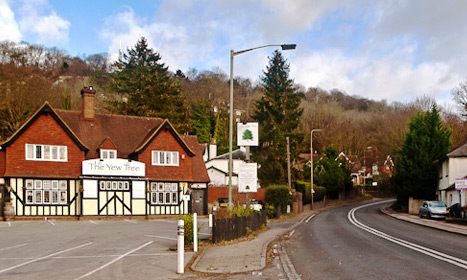
The gradient increases from the infamous speed camera to the Yew Tree pub, which
was there in 1880 (although the present building dates from 1938), giving a
taste of what's to come. Incidentally, the spectators in 1880 had a choice of
pubs at this point, as opposite the Yew Tree was The Rifle Volunteer which
closed in 1907 and is now a private house.
 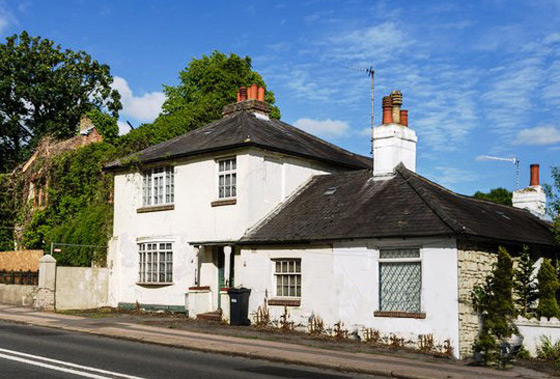
After the Yew Tree the gradient eases off for the next couple of hundred yards
as the road swings right then steepens as we bear left to start the relentless
drag towards the footbridge. The original 'tramway' was probably on this final
half mile to the summit. The footbridge is now in sight but my pedalling speed
has reduced while my rate of breathing has increased! Keeping the momentum
going, albeit rather slowly, the gradient eases slightly as I pass under the
footbridge and stop the clock.

My time? A rather miserable 12 minutes 18 seconds I'm afraid, compared with
Charles Crute's winning time in 1880 of 8.5 minutes! The only excuse I can
offer, apart from the head-wind is that I was probably giving away around 50
years to those young riders! It shows how superbly fit and skilful these riders
were, riding on unmade roads and negotiating the narrow paving of the tramway.
 
I admire them immensely, particularly the efforts of Herbert Liddell Cortis, who
came equal second in a time of nine minutes, despite riding with one arm in a
sling, having been injured two days before the event in an attempt to ride 20
miles in one hour at the Surbiton track. When approaching the nineteenth mile
and with the record looking achievable, two of his four man team of pacers
touched wheels during a change-over and went down in front of him, with Cortis
going over the top. The holder of many amateur championships and records, Cortis
was the first cyclist to ride 20 Miles in the hour (20 miles 300 yards) In 1882
at the Crystal Palace track. He qualified as a Doctor at Guys hospital, got
married and emigrated to Australia where sadly he died from a stomach ulcer at
the age of 27. These days, Reigate Hill is far from 'unrideable to most
cyclists' as described in 'The Cyclist' journal report of September 8th 1880. A
regular cyclist on a modern multi-gear bike would ascend it without too much
difficulty, although it would still require quite an effort to match Charles
Crute's time of 8.5 minutes!
 
There were no spectators as such for my ride but I did have official SVVS
photographers in the form of my wife Janet, our Editor Malcolm Ward and his son
Darren with his family, to whom I am grateful for turning out at an early hour
and for the pictures they have taken.
 Chas
Moody Chas
Moody
 
The
Mid Surrey Mirror The
Bicycle Ride of Reigate Hill
September
11th 1880,
"We can readily believe that many of those attracted to Reigate Hill had no
serious interest in bicycling matters and would fain have to confess a total
ignorance of the distinguishing characteristics of the various machines passing
them, save that they could swear to an "Xtraordinary" when they saw
one - which was not often; but, given a delightful day, most charming scenery, a
well-dressed crowd of promenaders, and intermittent excitement, it is not to be
wondered that the occasion was made the excuse for flirtation ad. lib., and
therefore was well patronised.
The
wind blew straight up the hill, helping the machinists considerably. We don't
want to disparage the performance of the successful competitors, but we must
admit that there is considerable justice in the remark of a correspondent to a
sporting newspaper, who contends that the stone tramway with which the road is
laid helps the practised rider very much, but to the novice is like enough to
prove a snare. In short, that those who practice the hill will stand the best
chance, those who come strange to it the worst.
Results, we think we are correct in stating, proved the wisdom of the verdict;
for Crute, of Sutton, one of those who made the ascent in good style, has of
late, it would seem, devoted a considerable amount of time to the subjection of
the hill. The riders had the choice of either kerbing, which is rather more than
a foot wide, but once on they could not, except at the risk of a dismount, leave
the narrow track. It is true Hutchins (Brixton Ramblers) went off, but he
cleverly regained the track; D. W. Major (Twickenham) came to grief on the
stones. The appearance of this causeway argued that care had been taken to get
rid of all likely obstacles, so that everything may be said to have been in
favour of the bicyclists. The apparent ease with which H. L. Cortis, who rode
with one hand in a sling, although having withdrawn from the competition
achieved the feat of ascending the hill, in some people's eyes rather lessened
the value of the efforts put forth by competitors who enjoyed more helpful
conditions, but these were they who forgot Cortis's remarkable powers - powers
which earned him the amateur championship and suggested the title,
"Demon", by which he is dubbed by the Referee. The particulars of his accident, two days before, at
Surbiton, when he attempted to ride 20 miles in an hour, but was involved in a
general smash after he had completed 18 miles, with disastrous consequences to
himself and two other men, were pretty well known, and attracted to the plucky
rider much sympathy, especially at the hands - or hearts? - of the fair sex.
Before going any further we may briefly review the circumstances under which the
race was arranged. The Surrey Bicycle Club must have the credit of its origin.
The race was suggested in consequence of the frequency of the reports,
circulated by this and that claimant, that he had ridden Reigate Hill. Taking
it, perhaps, for granted that Reigate Hill was worth riding, the old club
determined upon the arrangement of a trial ride, in which those who alleged
having surmounted the hill, without a dismount, should be invited to repeat the
feat, and to receive, on doing so, a handsome bronze medal, in proof of its
achievement.
Entries were very numerous - some 155 in all - and the committee had a very
delicate task in the selection of a favoured 74; these competitors were balloted
for and every care was made to ensure the general representative character of
the contest; the result being that the official list (which we published gratis,
in the absence of a Club Programme) showed the names of several clubs from all
parts of England, represented in most cases by no more than one member.
"Unattached" cyclists were
also permitted to ride.
Of these 74 we, on the authority of the Bicycling
Times (to the courtesy of whose editor we are indebted for authentic
information), 43 actually essayed the ascent, and 20 succeeded in getting to the
top. Some chose the left and some the right hand kerbing. Members of the Surrey
Bicycle Club were stationed along the line of route to watch competitors, and
report, if necessary, deception; stewards were also appointed to jot down
remarks, and take the times of the riders when they reached particular points.
The distance from the starting point, at the Grapes, and the finish, a dozen
yards or so beyond the Suspension Bridge, was 7,920 ft., the steepest gradient
being 12 ft. in the 100. The average being 4 ft. 6 in. in the 100. The average
gradient on the tram-line is 10 ft. in the 100. Mr. W. J. Keen acted as starter
and took each competitor's time. Each rider bore an official card number, and
thus it was easy for him to be distinguished by the stewards. At the turnpike
observations were taken, and again at the commencement of the tramway. Here also
the exact time of each arrival was noted, and a calculation showed the period
occupied by each upon the journey so far. Half way up the tramway other
detectives were placed, and finally at the goal the successful riders were
received by Mr. C. J. Fox, jun., editor of the Bicycling Times, who acted as timekeeper. The level crossing at the
Railway Station was the centre of a crowd of people, who no doubt anticipated
accidents; the trains, however, were not allowed to interfere with the
proceedings, the bicyclists being started at times calculated not to clash with
them. The police are to be credited with much attention.
The whole line of route was thronged with spectators, who remained until the
proceedings began to get monotonous, when they thinned considerably. The
starting point, in the Market Place, was by no means an exciting situation, the
middle of the tramway and the summit, the most difficult points, being the most
in favour by the public. As the riders neared these they were cheered on by
their intimate friends, and excited to use fresh exertions, and as they
succeeded they were warmly greeted by those at the top.
We
subjoin a summary of the official report on each rider.
The first to start (at 4.38 p.m.)* was G. H. Coleman, Leytonstone, who went easy
to the turnpike, and continued steadily up the tramway to the goal, which he
reached in twelve minutes. The next to succeed was A. P. C. Percival, Wanderers,
who arrived at the tramway in eight minutes, and came up it very fast, beating
his predecessor by one minute, in point of time taken on the whole journey. Four
minutes afterwards came G. H. Godbolt, Civil Service, who, having gone steadily
nearly the whole distance, grew rather shaky as he approached the Suspension
Bridge, which he also gained in eleven minutes. Crute, of Sutton, was the next
man up, and his splendid going earned him justly accorded applause.
Unfortunately his time, manifestly fast, appeared not "gettable". E.
J. Abraham, Isle of Wight, who had been passed by Crute, arrived half a minute
later; he appeared to find it hard work on the causeway; his time is given as
six and a half minutes. [to the tramway, CM]. The 6th man was J. R. Hamilton,
Druids, who rode all the way up in good style and occupied nine minutes. C. W.
Coe, S.L.A. and B.C., followed, and took it very easy until on the tramway, when
he began to "wobble;" he went up it, however, fairly well, and
finished seventh in 13.5 minutes. C. Gingell, Invicta, took eleven minutes,
getting on well on the tramway as soon as he had become accustomed to it. The
same remarks apply to C. H. Pagniez, Athenĉum. For seven minutes the track was
pretty well clear, then came George Hunter, Leatherhead, who went well all the
way, and made the spectators think the ride was rather easy, however one or two
failures altered that opinion, but the appearance of F. P. Durant, of Dorking,
who took 10 minutes - the same time as his immediate forerunner - going easy and
well, again led the public to underrate the difficulties of the ascent. Those
who saw R. E. Phillips who followed, but failed, wobbling about, and in manifest
difficulty, held however, different views.
F. Hutchins was the next to finish, taking 12 minutes, and not until he had
finally left the causeway did he get out of difficulties. P. Neville, no club,
and H. R. Reynolds, D.D. and L, 11minutes after came up together, the latter
rather done, feeling, no doubt, the effect of his struggling at the turnpike.
The former's time is not given, the latter's was 15 minutes. Further excitement
was occasioned , by another pair, who raced in together, both having started and
both finishing in the same time, completing the distance in 10 minutes. These
were F. G. Neville, London, and F. M. Payne, C.B.I.C.. G. Morgan, of Bristol,
three and a half minutes later, rode in gamely, but he took 11.5 minutes. R. L.
Philpot, Sevenoaks, finished 18th in 11 minutes. Then came M. D. Rücker, jun.,
whose whole performance was first rate, although his time was 12 minutes. The
last to arrive was G. McCaffrey, Brixton, who finished very well at 6.18, having
started at 6.7, occupying in his moderately easily ridden ascent, 11 minutes.
Soon afterwards Mr. Fox was brought word by a non-entered bicyclist, who
succeeded in riding the Hill, that "all was over."
With regard to the non-successful riders, C. W. Cramphorn, of Sydenham,
fell on the tramway: Darlington, Budd, Whitaker, and Oliver found it too much
before getting half-way; Chiesman and Oram failed at middle distance; C. W.
Watkins, H. Blackwell, jun., C. W. Major, J. P. Hitchcock, W. Lewin (who fell
off at the corner), S. G. Tomkins, R. E. Philips, J. B. Sanders, F. W. Ashford,
W. Cunningham (who missed the tramway repeatedly), H. Williams, jun., G. E.
Watson, G. B. Brown, and A. P. Shaw (who came over the handles), who, having
succeeded with varying degrees of ease or difficulty in passing difficult
points, nevertheless failed to put in an appearance at the finish and swelled
the number of riders "jacked up" up by the roadside.
Only one machine
broke - that of F. S. Buckingham (Brixton Ramblers), who had the backbone smash
close up to the handles as he was entering the tramway.
The
day closed with a "high tea," provided by Mrs. Pitcher, of the Grapes,
at the Temperance Hall, which had been engaged to provide roomy accommodation
for the guests; but which proved rather inconveniently crowded. It was then
announced that the medals will be given at the next Surrey race meeting.
*Note
- G. H. Coleman started at 4.28 pm and not at 4.38pm as reported.
Nice to see that some things about the Surrey Mirror haven't changed
Go to Recent Venues
Page
PICTURE GALLERY INDEX
|















